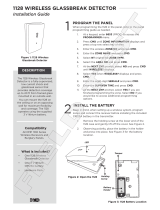
Testing in the MANual Mode (Continued):
1. Set the FG-701 switches to the TEST and MANual modes. (See
Figure 3.)
2. Position the FG-701 near the protected glass and point the speaker
directly at the glassbreak detector. Watch the green LED on the
detector.
3. Press the red start button and the FG-701 will generate a burst of glass-
break audio.
If the LED on the detector flashes, the range is acceptable for audio.
If the LED does not flash, move the detector closer to the glass and try
again. (On FG-1000 series detectors, the green LED will momentarily
turn off.)
BATTERY ANNOUNCEMENT
When the battery is low, the simulator sound will be interrupted by the word
"BATTERY." The battery should then be replaced.
Use only 9V alkaline batteries. Do not use carbon-zinc or rechargeable
Ni-Cd batteries because they don't have sufficient peak power capacity.
Honeywell and FlexGuard are registered trademarks of Honeywell International, Inc.
Copyright 2005 Honeywell.
All Rights Reserved.
5-051-320-00 Rev C
PRODUCT SPECIFICATIONS
Temperature Range
Operating: 32o F to 122o F (0o C to +50o C)
Storage: -4o F to +140o F (-20o C to +60o C)
Output Spectral Range:
1.5 - 16 kHz
Estimated Battery Life:
2500 operations (MANual mode)
Battery Type:
9V Alkaline, Duracell MN1604 or equivalent
Output Level:
Peak SPL of 102 dB at 1 meter, on axis
Dimensions:
3.25" W x 6.3" H x 0.9" D (83 mm x 160 mm x 23 mm)
Weight:
8 oz. (.23 kg)
TECHNICAL NOTES
When a pane of glass is broken by an impact, many variables affect the
sound it produces. Depending on the type of glass, its size and thickness,
type of mounting, the breaking instrument, and the force with which it is
struck, the sound it produces varies. In addition, the sounds will be modified
by absorptive or reflective surfaces in the room where the glassbreak
detector is located.
While no simulator can account for all possible conditions, the sound
produced by the FG-701 is carefully designed to represent the more difficult
cases. The sound is an enhanced digital recording of a small pane of
tempered glass broken in a controlled environment. The output level of the
simulator is correlated with the original sound to insure an equivalent
response in FlexGuard® detectors. In production, the acoustic output is
factory-calibrated to insure uniform performance.
Room characteristics greatly affect the apparent detection range indicated
by the simulator. In a room with hard walls, floor, and ceiling, the audio range
will be much greater than in a room with absorbing surfaces such as carpets
and acoustic tiles. This is because hard surfaces reflect the sound back into
the room, reinforcing it at points far from the simulator. Actual glassbreak
sound is affected in the same way as the simulator sound, since it has the
same frequency content and originates from the same location in the room.
Thus the audio range achieved with the FG-701 is a good indication of
glassbreak detection range, independent of the room characteristics.
In FLEX mode, the low-frequency signal is generated by striking the
protected glass. If sufficient flex can be generated by a safe, non-breaking
blow to the glass, there is good assurance that an actual break will be
detected.
Range indicated by the simulator should be considered the safe detection
range for an individual detector. Because of component tolerances, it
should not be assumed that a substitute detector will work at the same range.
If a detector is changed, the replacement should also be tested with the FG-
701.
Approvals/listings:
CE
C-Tick
Customers in European Union countries are advised to dispose
of this product, at the end of its useful life, as per applicable local
laws, regulations and procedures.
To obtain applicable EU compliance Declaration of Conformities for this
product, please refer to our Website,
http://www.security.honeywell.com/hsce/international/index.html.
For any additional information regarding the compliance of this product
to any EU specific requirements, please contact:
Quality Assurance Department,
Honeywell Security & Custom Electronics,
Newhouse Industrial Estate
Motherwell,
Lanarkshire ML1 5SB,
Scotland,
United Kingdom.
Tel: +44(0)1698 738200





